結構化查詢語言或 SQL 是一種標準資料庫語言,用於從 MySQL、Oracle、SQL Server、PostgreSQL 等關聯式資料庫中建立、維護、銷毀、更新和檢索資料。
它是一個用來描述資料庫中資料結構的概念架構。它旨在以更抽象的方式表示現實世界的實體及其之間的關係。這類似於程式語言的物件導向程式設計。
實體:這些是現實世界中具有獨特存在的物件或“事物”,例如客戶、產品或訂單。
關係: 這些定義實體如何相互關聯。例如,「客戶」實體可能與「訂單」實體有關係
指令:
create database <database_name>;
show databases;
use <database_name>
DESCRIBE table_name;
用於對資料執行查詢的語言。該命令用於從資料庫中檢索資料。
指令:
1) 選擇:
select * from table_name; select column1,column2 from table_name; select * from table_name where column1 = "value";
用來定義資料庫模式的語言。該命令用於建立、修改和刪除資料庫,但不用於資料。
指令
1) 建立:
create table table_name( column_name data_type(size) constraint, column_name data_type(size) constraint column_name data_type(size) constraint );
2) 掉落:
此命令完全刪除表/資料庫。
drop table table_name; drop database database_name;
3) 截斷:
此命令僅刪除資料。
truncate table table_name;
4) 更改:
該命令可以新增、刪除或更新表的列。
加
alter table table_name add column_name datatype;
修改
alter table table_name modify column column_name datatype; --ALTER TABLE employees --MODIFY COLUMN salary DECIMAL(10,2);
掉落
alter table table_name drop column_name datatype;
用於操作資料庫中存在的資料的語言。
1) 插入:
此指令用於僅插入新值。
insert into table_name values (val1,val2,val3,val4); //4 columns
2)更新:
update table_name set col1=val1, col2=val2 where col3 = val3;
3) 刪除:
delete from table_name where col1=val1;
GRANT:允許指定使用者執行指定任務。
REVOKE:取消先前授予或拒絕的權限。
它用於管理資料庫中的事務。它管理 DML 命令所做的更改。
1) 提交
用於將目前交易期間所做的所有變更儲存到資料庫
BEGIN TRANSACTION; UPDATE employees SET salary = salary * 1.1 WHERE department = 'Sales'; COMMIT;
2) 回滾
它用於撤銷目前交易期間所做的所有變更
BEGIN TRANSACTION; UPDATE employees SET salary = salary * 1.1 WHERE department = 'Sales'; ROLLBACK;
3) 保存點
begin transaction; update customers set first_name= 'one' WHERE customer_id=4; SAVEPOINT one; update customers set first_name= 'two' WHERE customer_id=4; ROLLBACK TO SAVEPOINT one; COMMIT;
此指令用於根據聚合函數過濾結果。 「我們不能在 WHERE 語句中使用聚合函數,因此我們可以在此命令中使用」
注意:當我們需要使用組成列進行比較時可以使用此命令,而 WHERE 命令可用於使用現有列進行比較
select Department, sum(Salary) as Salary from employee group by department having sum(Salary) >= 50000;
當他們要求排除任何兩個/更多特定項目時使用此命令
select * from table_name
where colname not in ('Germany', 'France', 'UK');
此指令用於根據所選欄位僅檢索唯一資料。
Select distinct field from table;
SELECT COUNT(DISTINCT salesman_id) FROM orders;
它是一個子查詢(嵌套在另一個查詢中的查詢),引用外部查詢中的列
SELECT EmployeeName, Salary
FROM Employees e1
WHERE Salary > (
SELECT AVG(Salary)
FROM Employees e2
WHERE e1.DepartmentID = e2.DepartmentID
);
標準化是一種資料庫設計技術,用於以減少冗餘並提高資料完整性的方式組織表。規範化的主要目標是將大表分成更小、更易於管理的部分,同時保留資料之間的關係
第一範式 (1NF)
列中的所有值都是原子的(不可分割的)。
每列僅包含一種類型的資料。
EmployeeID | EmployeeName | Department | PhoneNumbers ---------------------------------------------------- 1 | Alice | HR | 123456, 789012 2 | Bob | IT | 345678
1NF之後:
EmployeeID | EmployeeName | Department | PhoneNumber ---------------------------------------------------- 1 | Alice | HR | 123456 1 | Alice | HR | 789012 2 | Bob | IT | 345678
第二範式 (2NF)
它位於 1NF。
所有非鍵屬性在功能上完全依賴主鍵(沒有部分依賴)。
EmployeeID | EmployeeName | DepartmentID | DepartmentName --------------------------------------------------------- 1 | Alice | 1 | HR 2 | Bob | 2 | IT
2NF之後:
EmployeeID | EmployeeName | DepartmentID --------------------------------------- 1 | Alice | 1 2 | Bob | 2 DepartmentID | DepartmentName ------------------------------ 1 | HR 2 | IT
第三範式(3NF)
它位於 2NF。
所有屬性在功能上僅依賴主鍵(無傳遞依賴)。
EmployeeID | EmployeeN | DepartmentID | Department | DepartmentLocation -------------------------------------------------------------------------- 1 | Alice | 1 | HR | New York 2 | Bob | 2 | IT | Los Angeles
3NF之後:
EmployeeID | EmployeeN | DepartmentID ---------------------------------------- 1 | Alice | 1 2 | Bob | 2 DepartmentID | DepartmentName | DepartmentLocation ----------------------------------------------- 1 | HR | New York 2 | IT | Los Angeles
此指令用來組合兩個或多個 SELECT 語句的結果
Select * from table_name WHERE (subject = 'Physics' AND year = 1970) UNION (SELECT * FROM nobel_win WHERE (subject = 'Economics' AND year = 1971));
此指令用於限制從查詢中檢索的資料量。
select Department, sum(Salary) as Salary from employee limit 2;
此指令用於在傳回結果之前跳過行數。
select Department, sum(Salary) as Salary from employee limit 2 offset 2;
This command is used to sort the data based on the field in ascending or descending order.
Data:
create table employees (
id int primary key,
first_name varchar(50),
last_name varchar(50),
salary decimal(10, 2),
department varchar(50)
);
insert into employees (first_name, last_name, salary, department)
values
('John', 'Doe', 50000.00, 'Sales'),
('Jane', 'Smith', 60000.00, 'Marketing'),
('Jim', 'Brown', 60000.00, 'Sales'),
('Alice', 'Johnson', 70000.00, 'Marketing');
select * from employees order by department; select * from employees order by salary desc
This command is used to test for empty values
select * from tablename where colname IS NULL;
This command is used to arrange similar data into groups using a function.
select department, avg(salary) AS avg_salary from employees group by department;
This command is used to search a particular pattern in a column.
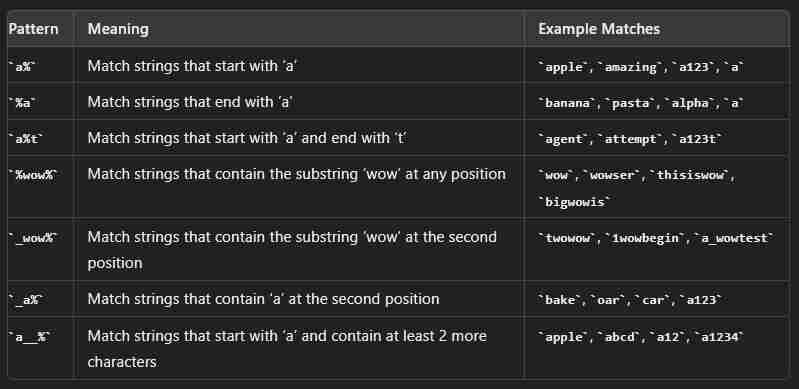
SELECT * FROM employees WHERE first_name LIKE 'a%';
SELECT * FROM salesman WHERE name BETWEEN 'A' AND 'L';
Characters used with the LIKE operator to perform pattern matching in string searches.
% - Percent
_ - Underscore
SELECT 'It\'s a beautiful day';
SELECT * FROM table_name WHERE column_name LIKE '%50!%%' ESCAPE '!';
The CASE statement in SQL is used to add conditional logic to queries. It allows you to return different values based on different conditions.
SELECT first_name, last_name, salary,
CASE salary
WHEN 50000 THEN 'Low'
WHEN 60000 THEN 'Medium'
WHEN 70000 THEN 'High'
ELSE 'Unknown'
END AS salary_category
FROM employees;
1) Print something
Select "message";
select ' For', ord_date, ',there are', COUNT(ord_no) group by colname;
2) Print numbers in each column
Select 1,2,3;
3) Print some calculation
Select 6x2-1;
4) Print wildcard characters
select colname1,'%',colname2 from tablename;
5) Connect two colnames
select first_name || ' ' || last_name AS colname from employees
6) Use the nth field
select * from orders group by colname order by 2 desc;
1) Not Null:
This constraint is used to tell the field that it cannot have null value in a column.
create table employees(
id int(6) not null
);
2) Unique:
This constraint is used to tell the field that it cannot have duplicate value. It can accept NULL values and multiple unique constraints are allowed per table.
create table employees (
id int primary key,
first_name varchar(50) unique
);
3) Primary Key:
This constraint is used to tell the field that uniquely identifies in the table. It cannot accept NULL values and it can have only one primary key per table.
create table employees (
id int primary key
);
4) Foreign Key:
This constraint is used to refer the unique row of another table.
create table employees (
id int primary key
foreign key (id) references owner(id)
);
5) Check:
This constraint is used to check a particular condition for data to be stored.
create table employees (
id int primary key,
age int check (age >= 18)
);
6) Default:
This constraint is used to provide default value for a field.
create table employees (
id int primary key,
age int default 28
);
1)Count:
select count(*) as members from employees;
2)Sum:
select sum(salary) as total_amount FROM employees;
3)Average:
select avg(salary) as average_amount FROM employees;
4)Maximum:
select max(salary) as highest_amount FROM employees;
5)Minimum:
select min(salary) as lowest_amount FROM employees;
6)Round:
select round(123.4567, -2) as rounded_value;
1) datediff
select a.id from weather a join weather b on datediff(a.recordDate,b.recordDate)=1 where a.temperature > b.temperature;
2) date_add
select date_add("2017-06-15", interval 10 day);
SECOND
MINUTE
HOUR
DAY
WEEK
MONTH
QUARTER
YEAR
3) date_sub
SELECT DATE_SUB("2017-06-15", INTERVAL 10 DAY);
This is used to combine two tables based on one common column.
It returns only the rows where there is a match between both tables.
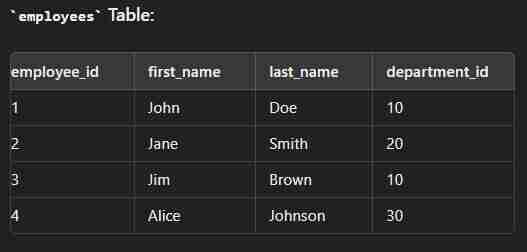
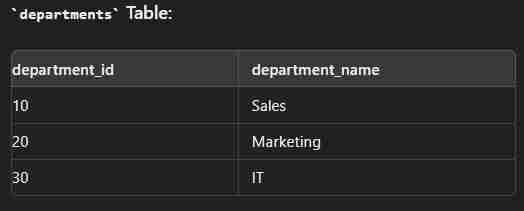
Data
create table employees( employee_id int(2) primary key, first_name varchar(30), last_name varchar(30), department_id int(2) ); create table department( department_id int(2) primary key, department_name varchar(30) ); insert into employees values (1,"John","Dow",10); insert into employees values (2,"Jane","Smith",20); insert into employees values (3,"Jim","Brown",10); insert into employees values (4,"Alice","Johnson",30); insert into department values (10,"Sales"); insert into department values (20,"Marketing"); insert into department values (30,"IT");
select e.employee_id,e.first_name,e.last_name,d.department_name from employees e inner join department d on e.department_id=d.department_id;
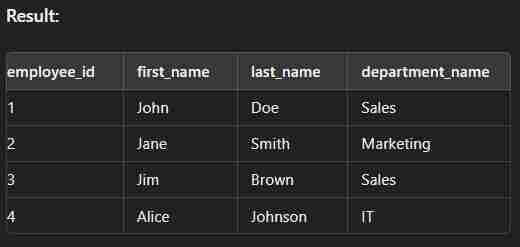
This type of join returns all rows from the left table along with the matching rows from the right table. Note: If there are no matching rows in the right side, it return null.
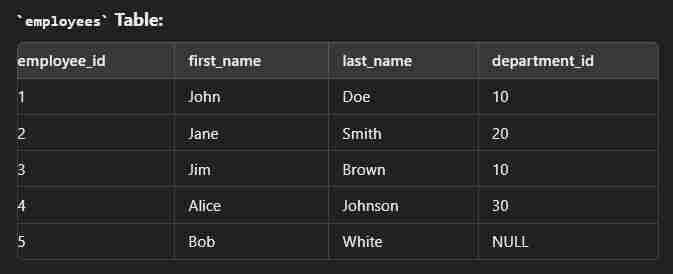
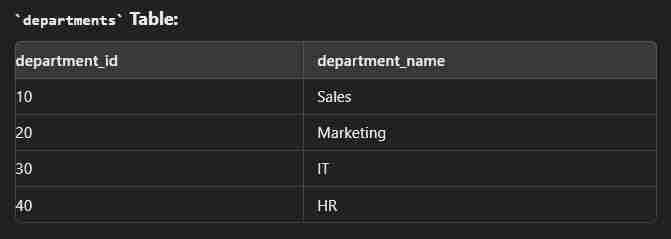
select e.employee_id, e.first_name, e.last_name, d.department_name from employees e left join departments d on e.department_id = d.department_id;
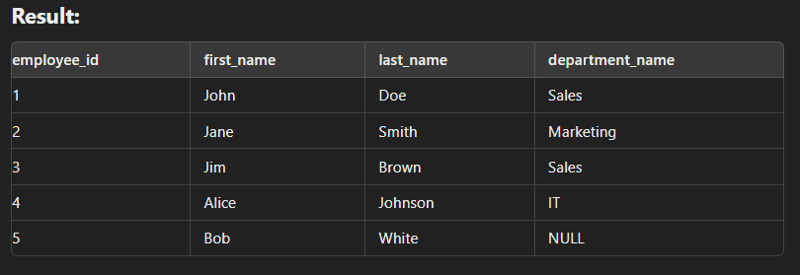
This type of join returns all rows from the right table along with the matching rows from the left table. Note: If there are no matching rows in the left side, it returns null.
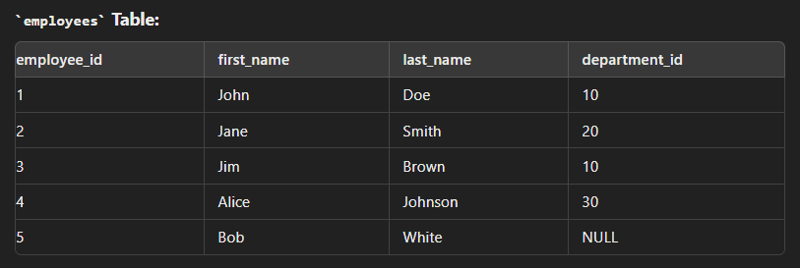

SELECT e.employee_id, e.first_name, e.last_name, d.department_name FROM employees e RIGHT JOIN departments d ON e.department_id = d.department_id;
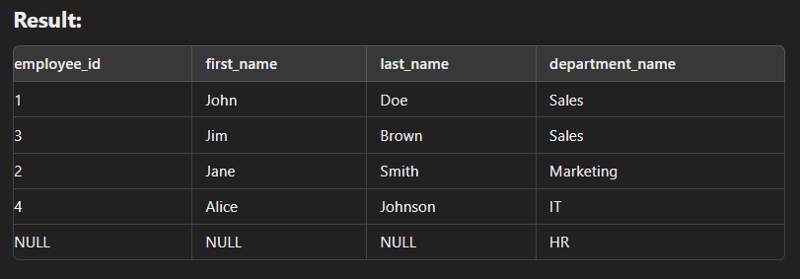
This type of join is used to combine with itself especially for creation of new column of same data.

SELECT e.employee_id AS employee_id,
e.first_name AS employee_first_name,
e.last_name AS employee_last_name,
m.first_name AS manager_first_name,
m.last_name AS manager_last_name
FROM employees e
LEFT JOIN employees m ON e.manager_id = m.employee_id;
This type of join is used to combine the result of both left and right join.


SELECT e.employee_id, e.first_name, e.last_name, d.department_name FROM employees e FULL JOIN departments d ON e.department_id = d.department_id;
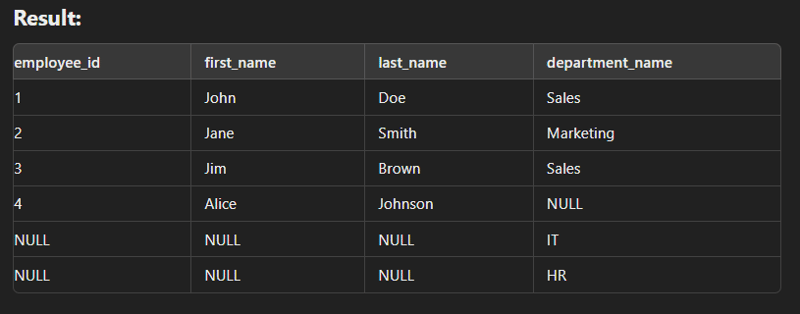
This type of join is used to generate a Cartesian product of two tables.
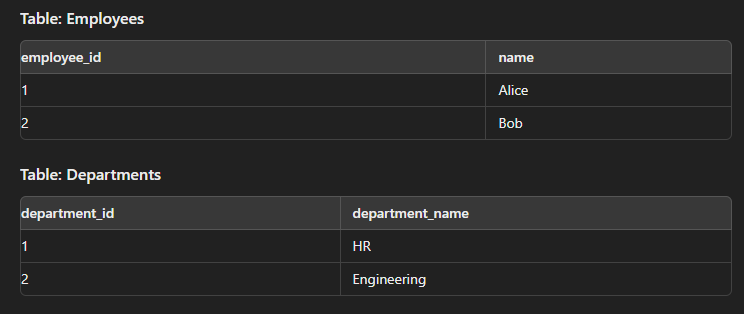
SELECT e.name, d.department_name FROM Employees e CROSS JOIN Departments d;

A nested query, also known as a subquery, is a query within another SQL query. The nested query is executed first, and its result is used by the outer query.
Subqueries can be used in various parts of a SQL statement, including the SELECT clause, FROM clause, WHERE clause, and HAVING clause.
1) Nested Query in SELECT Clause:
SELECT e.first_name, e.last_name,
(SELECT d.department_name
FROM departments d
WHERE d.id = e.department_id) AS department_name
FROM employees e;
2) Nested Query in WHERE Clause:
SELECT first_name, last_name, salary FROM employees WHERE salary > (SELECT AVG(salary) FROM employees);
SELECT pro_name, pro_price FROM item_mast WHERE pro_price = (SELECT MIN(pro_price) FROM item_mast);
3) Nested Query in FROM Clause:
SELECT department_id, AVG(salary) AS avg_salary FROM employees GROUP BY department_id;
4) Nested Query with EXISTS:
SELECT customer_name
FROM customers c
WHERE EXISTS (
SELECT 1
FROM orders o
WHERE o.customer_id = c.customer_id
);
This command is used to test the existence of a particular record. Note: When using EXISTS query, actual data returned by subquery does not matter.
SELECT customer_name
FROM customers c
WHERE EXISTS (
SELECT 1
FROM orders o
WHERE o.customer_id = c.customer_id
);
SELECT customer_name
FROM customers c
WHERE NOT EXISTS (
SELECT 1
FROM orders o
WHERE o.customer_id = c.customer_id
);
The COALESCE function in SQL is used to return the first non-null expression among its arguments. It is particularly useful for handling NULL values and providing default values when dealing with potentially missing or undefined data.
CREATE TABLE employees (
first_name VARCHAR(50),
middle_name VARCHAR(50),
last_name VARCHAR(50)
);
INSERT INTO employees (first_name, middle_name, last_name) VALUES
('John', NULL, 'Doe'),
('Jane', 'Marie', 'Smith'),
('Emily', NULL, 'Johnson');
SELECT
first_name,
COALESCE(middle_name, 'No Middle Name') AS middle_name,
last_name
FROM
employees;
It is Oracle's procedural extension to SQL. If multiple SELECT statements are issued, the network traffic increases significantly very fast. For example, four SELECT statements cause eight network trips. If these statements are part of the PL/SQL block, they are sent to the server as a single unit.
They are the fundamental units of execution and organization.
1) Named block
Named blocks are used when creating subroutines. These subroutines are procedures, functions, and packages. The subroutines can be stored in the database and referenced by their names later on.
Ex.
CREATE OR REPLACE PROCEDURE procedure_name (param1 IN datatype, param2 OUT datatype) AS BEGIN -- Executable statements END procedure_name;
2) Anonymous
They are blocks do not have names. As a result, they cannot be stored in the database and referenced later.
DECLARE -- Declarations (optional) BEGIN -- Executable statements EXCEPTION -- Exception handling (optional) END;
Declaration
It contains identifiers such as variables, constants, cursors etc
Ex.
declare v_first_name varchar2(35) ; v_last_name varchar2(35) ; v_counter number := 0 ; v_lname students.lname%TYPE; // takes field datatype from column
DECLARE v_student students%rowtype; BEGIN select * into v_student from students where sid='123456'; DBMS_OUTPUT.PUT_LINE(v_student.lname); DBMS_OUTPUT.PUT_LINE(v_student.major); DBMS_OUTPUT.PUT_LINE(v_student.gpa); END;
Execution
It contains executable statements that allow you to manipulate the variables.
declare v_regno number; v_variable number:=0; begin select regno into v_regno from student where regno=1; dbms_output.put_line(v_regno || ' '|| v_variable); end
DECLARE v_inv_value number(8,2); v_price number(8,2); v_quantity number(8,0) := 400; BEGIN v_price := :p_price; v_inv_value := v_price * v_quantity; dbms_output.put_line(v_inv_value); END;
IF rating > 7 THEN
v_message := 'You are great';
ELSIF rating >= 5 THEN
v_message := 'Not bad';
ELSE
v_message := 'Pretty bad';
END IF;
Simple Loop
declare
begin
for i in 1..5 loop
dbms_output.put_line('Value of i: ' || i);
end loop;
end;
While Loop
declare
counter number := 1;
begin
while counter <= 5 LOOP
dbms_output.put_line('Value of counter: ' || counter);
counter := counter + 1;
end loop;
end;
Loop with Exit
declare
counter number := 1;
begin
loop
exit when counter > 5;
dbms_output.put_line('Value of counter: ' || counter);
counter := counter + 1;
end loop;
end;
A series of statements accepting and/or returning
zero variables.
--creating a procedure create or replace procedure proc (var in number) as begin dbms_output.put_line(var); end --calling of procedure begin proc(3); end
A series of statements accepting zero or more variables that returns one value.
create or replace function func(var in number) return number is res number; begin select regno into res from student where regno=var; return res; end --function calling declare var number; begin var :=func(1); dbms_output.put_line(var); end
All types of I/O
p_name IN VARCHAR2 p_lname OUT VARCHAR2 p_salary IN OUT NUMBER
DML (Data Manipulation Language) triggers are fired in response to INSERT, UPDATE, or DELETE operations on a table or view.
BEFORE Triggers:
Execute before the DML operation is performed.
AFTER Triggers:
Execute after the DML operation is performed.
INSTEAD OF Triggers:
Execute in place of the DML operation, typically used for views.
Note: :new represents the cid of the new row in the orders table that was just inserted.
create or replace trigger t_name after update on student for each row begin dbms_output.put_line(:NEW.regno); end --after updation update student set name='name' where regno=1;
SELECT
id,name,gender,
ROW_NUMBER() OVER(
PARTITION BY name
order by gender
) AS row_number
FROM student;
SELECT
employee_id,
department_id,
salary,
RANK() OVER(
PARTITION BY department_id
ORDER BY salary DESC
) AS salary_rank
FROM employees;
Atomicity:
All operations within a transaction are treated as a single unit.
Ex. Consider a bank transfer where money is being transferred from one account to another. Atomicity ensures that if the debit from one account succeeds, the credit to the other account will also succeed. If either operation fails, the entire transaction is rolled back to maintain consistency.
一致:
一致性保證資料庫在交易前後保持一致的狀態。
例如如果一筆轉帳交易減少了一個帳戶的餘額,它也應該增加接收帳戶的餘額。這維持了系統的整體平衡。
隔離:
隔離性確保事務的並發執行會產生一種系統狀態,如果事務是串列執行的,即一個接一個地執行,則將獲得該系統狀態。
前任。考慮兩個事務 T1 和 T2。如果T1 將資金從帳戶A 轉移到帳戶B,並且T2 檢查帳戶A 的餘額,則隔離可確保T2 在轉帳之前(如果T1 尚未提交)或轉帳之後(如果T1 尚未提交)看到帳戶A 的餘額已提交),但不是中間狀態。
耐用性:
持久性保證事務一旦提交,其影響是永久性的並且不會受到系統故障的影響。即使系統崩潰或重啟,事務所所做的更改也不會遺失。
1) 數字資料型別
int
decimal(p,q) - p 是大小,q 是精確度
2) 字串資料型別
char(value) - max(8000) && 不可變
varchar(值) - max(8000)
文字 - 最大尺寸
3) 日期資料型別
日期
時間
日期時間
以上是SQL面試完整指南的詳細內容。更多資訊請關注PHP中文網其他相關文章!




